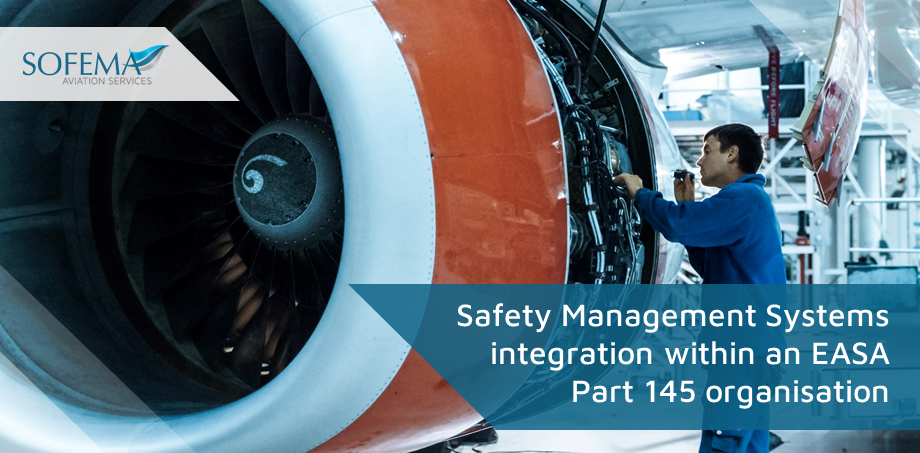Sofema Aviation Services (SAS) www.sassofia.com considers the primary aspects of Safety Management Systems (SMS) integration within an EASA Part 145 organization.
Introduction
Managing the implementation of Safety Management Systems (SMS) due to the revised European Union Aviation Safety Agency (EASA) Part 145 regulations involves thorough strategic planning and effective implementation.
An effective Safety Management Systems contain the following elements:
- Understanding the problem “What is wrong” – (hazard identification)
- Developing a solution “How to fix the issue” – (remedial action)
- Ensuring effective resolution of the problem “Has the fix worked” – (continuous monitoring)
- The ability to change & Improve “Ensuring both effectiveness and efficiency” – (continuous improvement)
What is involved in an SMS implementation plan:
Safety Management Systems implementation plans should typically include all of the following elements:
- Safety policy and objectives;
- Detailed system description;
- Full гap analysis performed & documented;
- Understanding of all SMS components;
- Safety roles and responsibilities;
- Hazard reporting policy;
- Means of engaging employees involved in your SMS program;
- Ability to deliver safety performance measurement and monitoring;
- Provision of safety training;
- Safety communication; and
- Management review of safety performance and system feedback.
Additionally to acknowledge the need to ensure sufficient resources related to the following areas: (Essential for a strong system)
Introduction EASA organizational performance management systems
Regulation 2021/1963 amends Continuing Airworthiness Regulation (EU) No 1321/2014 as regards safety management systems in maintenance organisations and correcting that regulation.
- Addition of clause 145.A.200 – Management system
o The organisation shall establish, implement and maintain a management system that includes clearly defined accountability and lines of responsibility throughout the organisation, including direct safety accountability of the accountable manager.
o The identification of aviation safety hazards entailed the activities of the organisation, their evaluation, and the management of the associated risks, including taking actions to mitigate the risks and verify their effectiveness.
o A function to monitor the compliance of the organisation with the relevant requirements. Compliance monitoring shall include a feedback system of findings to the accountable manager to ensure the effective implementation of corrective actions as necessary.
Best practices
- Gap analysis – Perform a comprehensive gap analysis to identify how the existing SMS differs from the new EASA requirements. This provides a foundation for prioritizing changes.
o Allocate a core team to conduct a gap analysis and review current Safety Management Systems practices against EASA Part 145 regulations.
- Change management plan – Develop a robust change management plan that identifies the areas of the SMS impacted and outlines a phased approach to implementation.
o Develop a change management strategy, SMS adjustments, training modules, and timelines.
o Develop role-specific training modules that cater to different staff responsibilities.
- Stakeholder engagement – Involve all relevant stakeholders early in the process, including management, safety officers, and operational personnel, to build consensus and reduce resistance.
- Training programs – Create a detailed training program that addresses the new regulatory requirements and how staff roles may evolve.
o Implement assessments to ensure that staff comprehensively understand the revised SMS procedures.
- Communication – Ensure transparent and consistent communication throughout the implementation process, keeping everyone informed of progress and timelines.
- Continuous monitoring – Implement an ongoing monitoring and feedback mechanism to evaluate compliance and make adjustments as required Timeline and Manpower.
o Establish a review cycle to regularly evaluate SMS performance and maintain compliance with evolving EASA standards.
Potential Issues of Concern
- In-effective Safety Reporting is due in part to a general lack of engagement as well as under-reporting of safety occurrences typically due to multiple factors including lack of either just culture or reporting culture.
- Manpower & process shortfalls in the management of the reporting processes, as well as a lack of effective management and analysis of the gathered SMS data.
- A general lack of an integrated approach, with the need for strong engagement between the role of safety, quality, security and the various business processes throughout the organisation.
- The challenge of external interface and or engagement with both contract & sub-contract service providers.
- Effective balance related to the cost of SMS resources (both human and software / technical) versus the “perceived” return on investment.
- The cost of training for all active service staff with the potential to impact safety throughout the organisation.
- A lack of effective support material available within the continuing airworthiness areas (both EASA Part CAMO & EASA Part 145) providing templates, structure & guidance for establishing safety targets and safety performance.
Next Steps
Check out our Download Area for additional resources – Please see the following page
Follow this link to our Library to find & download related documents for Free.
Sofema Aviation Services (SAS) and Sofema Online (SOL) provide Safety and Risk Management Training in the Classroom, as a Webinar or in the form of Online Courses. Please see the websites or email team@sassofia.com
Tags:
Aircraft Maintenance, Compliance, EASA, EASA Part 145, EASA requirements, Hazard Reporting, Aviation SMS Implementation, safety performance, Safety Reporting, Aviation safety training, SAS blogs, Continuing Airworthiness (CA), Safety roles, Safety Management Systems (SMS), Accountable Manager (AM), European Union Aviation Safety Agency (EASA)




